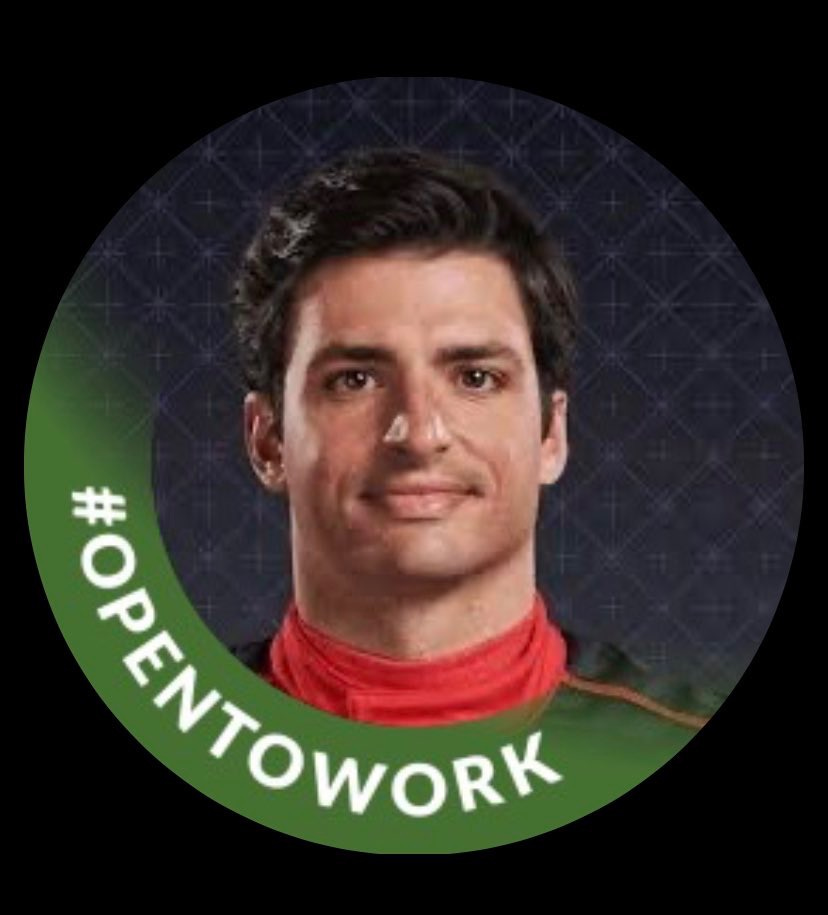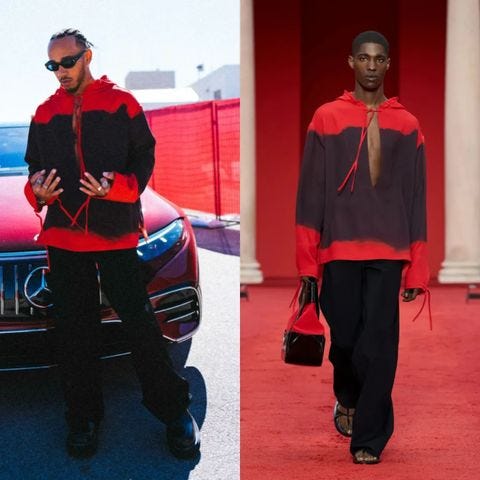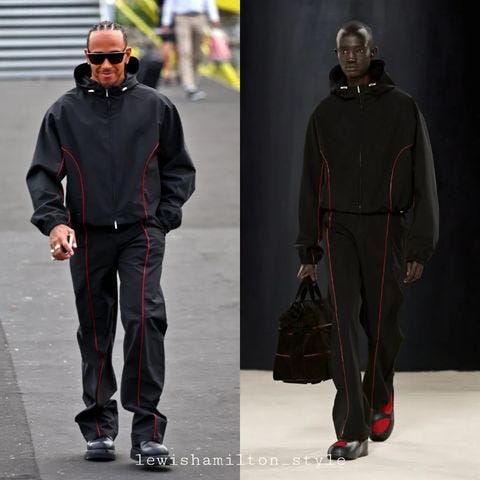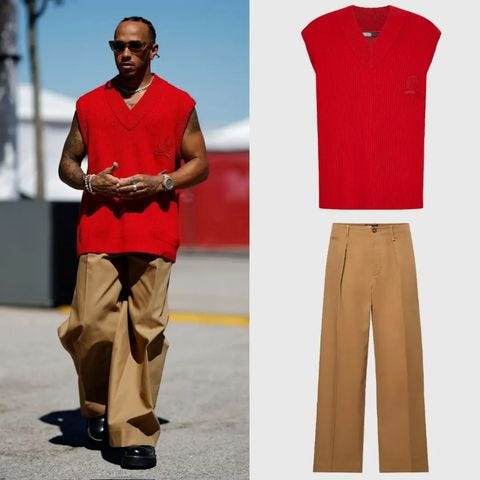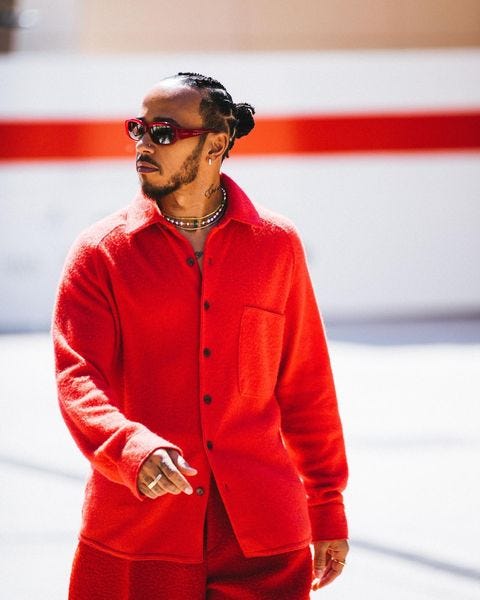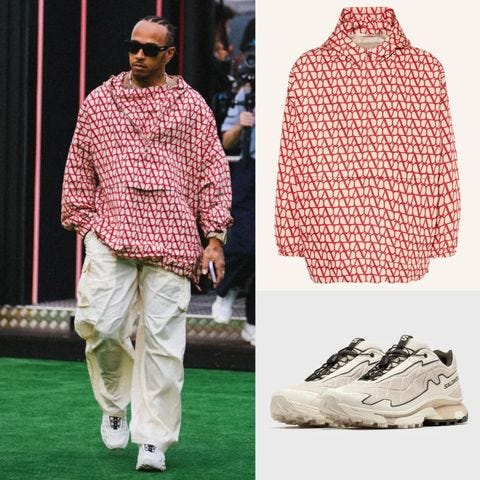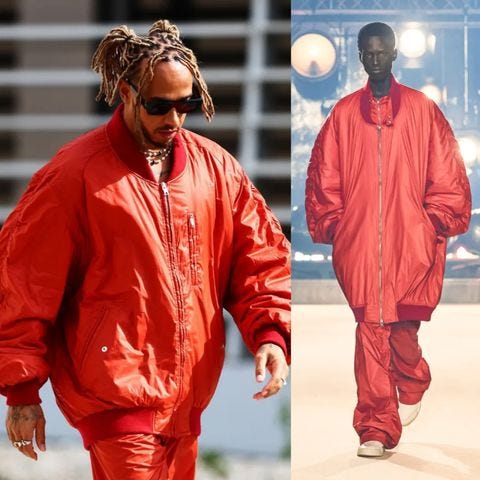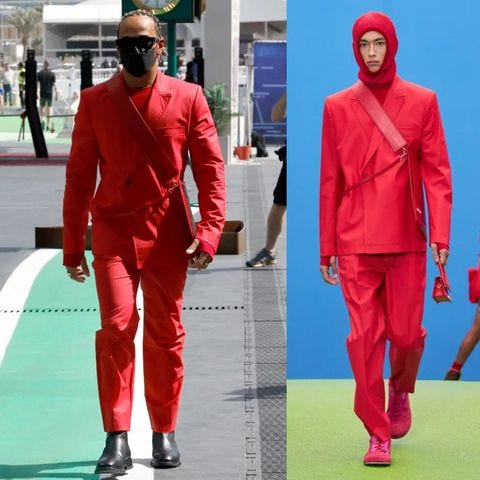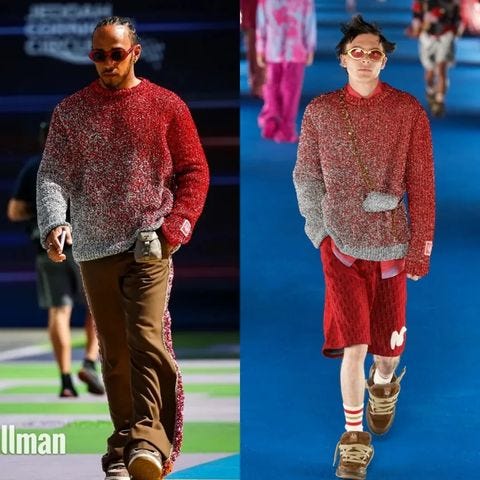Lewis Hamilton Sure Looks Good in Red
A toast to the icon on the eve of his last season with Mercedes
Once upon a time (earlier this month), a knight (in the modern sense of the term) declared (it was leaked) that he would be leaving his noble steed (Mercedes) in favor of The Prancing Horse (Ferrari). Or, in non-children’s story vernacular—Sir Lewis Hamilton, MBE, announced that after 11 years and seven world titles with the Mercedes-AMG PETRONAS F1 team, this upcoming season would be his last racing for the Silver Arrows. He’s 39 years old, but he isn’t retiring—he’ll be racing for Scuderia Ferrari come 2025. From a team color palette perspective, I am devastated; silver and black to red and yellow is objectively a downgrade. But given Lewis’ track record as one of the most fashionable people in the world, I believe that he must have considered this as well and still decided it was the right thing to do. Therefore, I give my blessing.
If I had any foresight, I would have already written about Formula 1. But I haven’t, so here’s a little background: F1 is defined by Wikipedia as the “highest class of international racing for open-wheel single-seater formula racing cars sanctioned by the Fédération Internationale de l'Automobile,” but to me, it is really the European version of NASCAR (meaning that it is sexier, sleeker, but still just cars driving in circles at the end of the day). Each Grand Prix (race) takes place in a different location across the globe, making the sport a true spectacle. There’s a guy named Max Verstappen who grinds my gears (haha) because he wins every race. It’s not his fault that he’s exponentially better than the rest of the grid (which is the F1 term for the lineup of racers) but god I would probably be way more into the sport if there wasn’t an 86% chance of him winning any given race. Because that’s what he did last season—the Dutchman won 19 out of 22 races and you can do the math. There are 10 F1 “constructors” (teams) with two drivers, and so many technicians and behind-the-scenes engineers. I am hesitant to call it a sport because in most ways it is a feat of science and a few hundred mechanical engineering degrees.
F1’s popularity stateside rose exponentially following the premiere of Netflix’s Formula 1: Drive to Survive, a documentary-style series that chronicles the lives of drivers, managers, and team owners on and off the track. The first season aired in 2019 to massive success, making superstars out of the sport’s most personable participants. All of a sudden, American women wanted to date Daniel Ricciardo, and American men wanted to be him. Charles Leclerc’s gorgeous green eyes became universally adored, and the subject of several TikTok fan cams. Turns out, all Formula 1 needed was to be marketed to American audiences; watching cars go vroom on television was no longer Dayton, Ohio coded—it was chic.
Drive to Survive has remade F1 in the United States; the show is said to have provided a halo effect that’s boosted live race viewership on ABC and ESPN. A poll by Morning Consult in March 2022 of nearly 1,900 self-identified adult U.S. F1 fans showed that 53 percent credited Drive to Survive as a reason they became viewers of F1 races. Per a Nielsen study, F1’s U.S. fan growth has increased by about 10 percent since the Netflix series debut, from an estimated 44.9 million American F1 fans in 2019 to 49.2 million in 2022.
One driver, however, needed no introduction; Sir Lewis Hamilton has served as a global ambassador of the sport for nearly two decades. Hamilton’s name is synonymous with F1—a larger-than-life, LeBron James-esque presence whose historic wins on the grid only tell a fraction of the story. When Hamilton joined McLaren-Mercedes in 2007, he became the first Black driver to ever race in the series. In his inaugural season, he finished runner-up by one point. In 2008, he dramatically won his first title—on the last lap of the 2008 Brazilian Grand Prix, the last race of the season—to become the then-youngest-ever Formula 1 World Champion. In 2013, Hamilton signed with Mercedes and has gone on to champion another six world titles, as well as diversity in F1 and beyond. In 2020, Hamilton was named among Time’s 100 most influential people, and at the end of 2021, was knighted in recognition of his achievements, influence, and service in motorsports and beyond.
Hamilton remains the only Black F1 driver, 16 years later. He’s suffered innumerable counts of racist abuse throughout his career, now using his platform to call on governing bodies across the globe to protect Black athletes. In 2020, Hamilton kneeled before every race and donned a Black Lives Matter helmet behind the wheel. His doctrine of outspokenness, especially in situations where he has everything to lose from doing so, has put the world on notice time and time again. His presence has corraled Formula 1 into being on the right side of history, his influence seemingly greater than that of everyone else in the sport. The same year, he established The Hamilton Commission with the Royal Academy of Engineering, a program dedicated to “finding ways in which motorsport can engage more young people from Black backgrounds with science, technology, engineering and mathematics subjects.”
“His activism has also moved the world. Lewis has brought international attention to the Black Lives Matter movement, through his advocacy on social media and at F1 events. Lewis’ mental preparation, his aura, his ability to capitalize on every opportunity to use his platform to drive out racism are more than just a model for race-car drivers and other athletes. He’s an inspiration for everyone,” wrote NASCAR driver Bubba Wallace in his Time profile.
Formula 1, much like soccer (and increasingly other sports globally), has been tainted by corruption; countries with dismal human rights records have paid massive sums to play host to a Grand Prix and benefit from the tourism and publicity this brings. A phenomenon called “sportwashing,” this practice generally describes nations, individuals, groups, corporations, or governments that use sports to improve reputations tarnished by wrongdoing. In F1, the more egregious examples of this can be found at the Bahrain Grand Prix, Hungarian Grand Prix, Qatar Grand Prix, and the Saudi Arabian Grand Prix. Prior to 2020’s race in Bahrain, an 11-year-old boy, Ahmed Ramadhan, wrote a letter to Hamilton, asking him to save his father, who was facing the death penalty, after a confession was allegedly extracted through torture for the death of a policeman. In the wake of this, Hamilton spent several months speaking to legal and human rights experts and Bahranian officials. “There are issues all around the world but I do not think we should be going to these countries and just ignoring what is happening in those places, arriving, having a great time and then leave,” Hamilton said at the press conference before the race.
All of that is just the tip of the iceberg. He’s an environmentalist, donated millions to charity, and is an outspoken advocate of LGBTQIA+ rights; he has always understood the power his position holds and the unique opportunity he has to create something better. Hamilton strongly criticized the Hungarian government before the 2021 Hungarian Grand Prix, while also calling out the "terrifying" Saudi Arabian LGBTQIA+ laws before that Grand Prix.
Long associated with Mercedes, the announcement of his switch to Ferrari put the world on pause. Ferrari are the Dallas Cowboys of Formula 1—a winning history that has yet to be replicated in the present. Does the Scuderia believe that Hamilton can infuse some championship DNA back into the team, even at 39? How long will Hamilton continue racing (both Ferrari and Hamilton have stated the contract is multi-year)? Is it looking past 2025, and what Hamilton can contribute to Ferrari when he does announce his retirement? And does his future off the grid now rest in Maranello, the small Italian town that Scuderia Ferrari calls home? I can speculate all I want, but what is certain as of now is that Carlos Sainz will be unemployed at the end of 2024—Buena suerte, Smooth Operator!
Another certainty is that Lewis Hamilton will continue pulling up to the track in the flyest possible fits, no matter how hard the sport tries to stop him. FIA dress code that bans the display of political, religious, and personal statements? Hertfordshire’s finest says "f that.” How about the embargo on earrings? Hamilton shows up with piercings on both ears and his nose, an act of solidarity with all of the girls whose high school coaches wouldn’t let them get their ears pierced during field hockey season. Everything Hamilton does, he does big—especially his style. A sartorial maximalist, Hamilton has spent his career redefining what a Formula 1 driver can be with accessories alone.
“I didn’t feel like I was welcome,” he told Vanity Fair. “I didn’t feel like I was accepted. God knows how many of these drivers say: ‘This is not what a Formula 1 driver is. That’s not how you behave. This is not how you do it. Tattoos? No! A Formula 1 driver doesn’t have tattoos! A Formula 1 driver doesn’t have a personality—and piercings!”
His fashion week foray with Tommy Hilfiger raised several eyebrows in 2020, but his performance later that week in Singapore silenced the critics. Lewis Hamilton has made it abundantly clear—he can and will do it all. He’s looked powerful in pink for Valentino campaigns, is a fashion show front-row regular, and loves his Zegna sweaters. If I had as much Tiffany & Co. jewelry as Sir Lewis, I’d be hard-pressed to take it off for a race too. He has been the saving grace of menswear and morality on Met Gala red carpets, most recently buying a table specifically to host Black designers who otherwise wouldn’t be able to afford a ticket at the event, who in turn brought and dressed Black VIP guests.
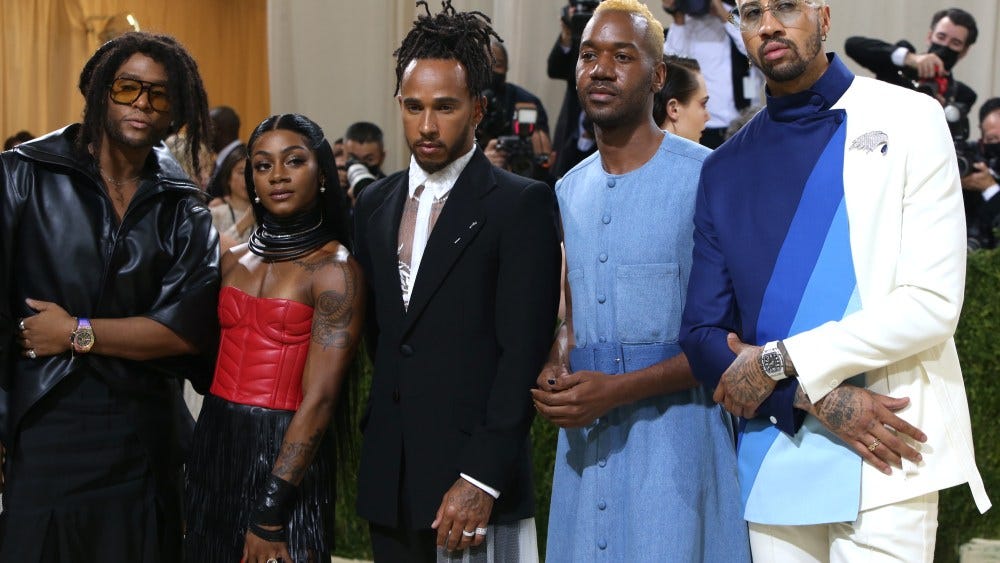
With the icon all set to switch to Ferrari in 2025, it’s only fitting to pay homage to his best fits—Scuderia-style. Expect to see Sir Lewis Hamilton in a lot more red in the near future, because he sure looks good in it.
Shoutout to Harun Sinanović, who fact-checked this story as my resident F1-obsessed friend.





